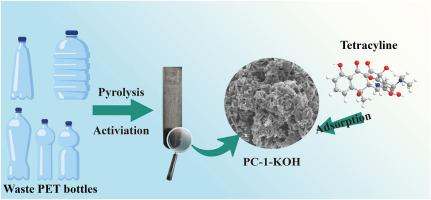废塑料微孔碳高效吸附四环素:吸附机理及应用前景。
IF 7.7
2区 环境科学与生态学
Q1 ENVIRONMENTAL SCIENCES
引用次数: 0
摘要
近年来,废塑料的积累和微塑料等塑料衍生污染物的出现,极大地推动了废塑料利用技术的发展和更新。本研究以废塑料瓶中的聚对苯二甲酸乙二醇酯(PET)为原料,采用KOH活化和熔融盐策略制备了多孔碳(PC-1-KOH)材料,以高效去除抗生素四环素(TC)。当PC-1-KOH质量为20 mg时,对TC的最大去除率为100.0%。在3 ~ 9的pH范围内及不同水体中,TC的去除率均保持在80.0%以上。拟二级动力学模型和Langmuir等温线描述了吸附过程,表明TC的吸附主要是化学性质的,并且发生在均匀表面上。孔隙填充、氢键、π-π堆积相互作用和静电相互作用是吸附TC的主要机理。这项工作展示了一种可持续的方法,将塑料废物衍生材料转化为功能材料,有效地消除污染和环境修复。本文章由计算机程序翻译,如有差异,请以英文原文为准。

Microporous carbon derived from waste plastics for efficient adsorption of tetracycline: Adsorption mechanism and application potentials
In recent years, the accumulation of waste plastics and emergence plastic-derived pollutants such as microplastics have driven significantly the development and updating of waste plastic utilization technology. This study prepared the porous carbon (PC-1-KOH) material directly from polyethylene terephthalate (PET) in waste plastic bottles using KOH activation and molten salt strategy for efficient removal of antibiotic tetracycline (TC). The maximum removal efficiency of TC was 100.0% with a PC-1-KOH weight of 20 mg. In addition, the TC removal efficiency stayed over 80.0% within the rage of pH of 3–9 and different water bodies. The adsorption process was described by the Pseudo-second-order kinetic model and the Langmuir isotherm, suggesting that the adsorption of TC was predominantly chemical in nature and occurred on a homogeneous surface. The pores filling, hydrogen bonding, π-π stacking interactions and electrostatic interaction are the main mechanisms of TC adsorption. This work demonstrates a sustainable approach to converting plastic waste derived materials into functional materials for effective pollution removal and environmental remediation.
求助全文
通过发布文献求助,成功后即可免费获取论文全文。
去求助
来源期刊

Environmental Research
环境科学-公共卫生、环境卫生与职业卫生
CiteScore
12.60
自引率
8.40%
发文量
2480
审稿时长
4.7 months
期刊介绍:
The Environmental Research journal presents a broad range of interdisciplinary research, focused on addressing worldwide environmental concerns and featuring innovative findings. Our publication strives to explore relevant anthropogenic issues across various environmental sectors, showcasing practical applications in real-life settings.
 求助内容:
求助内容: 应助结果提醒方式:
应助结果提醒方式:


